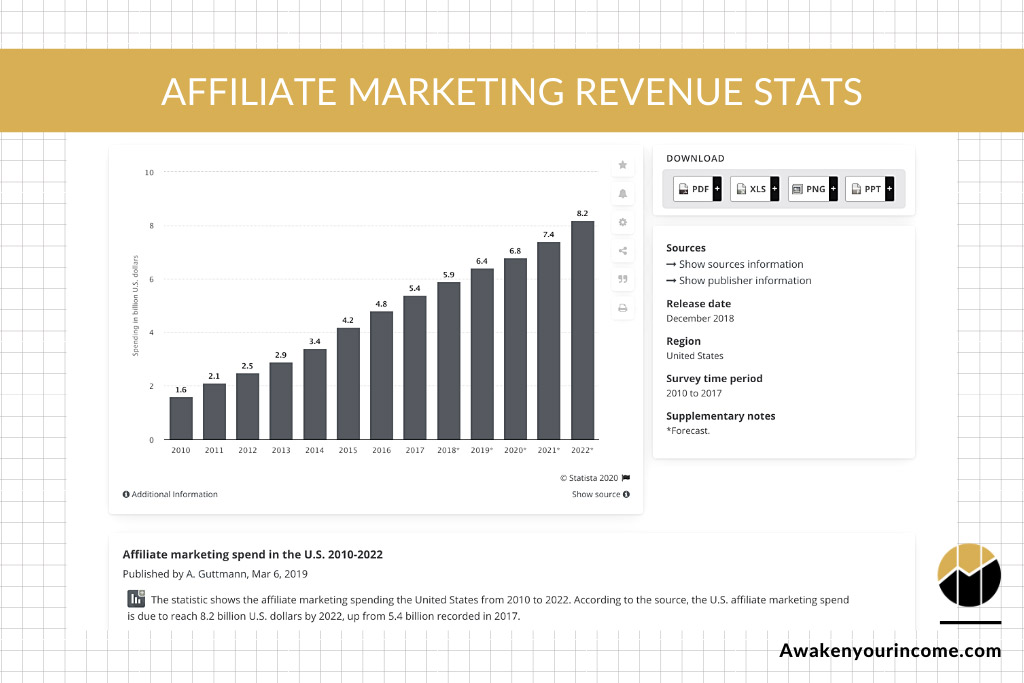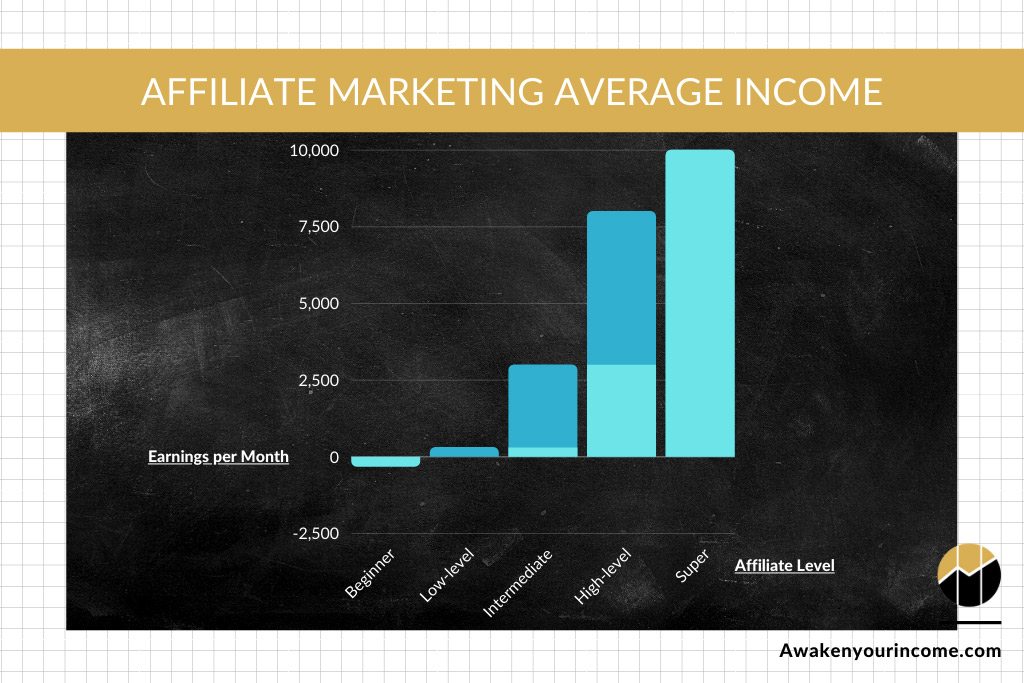Affiliate marketing is one of the many ways to make money online.
The attractive part of being an affiliate marketer is that you can get to make what’s known as passive income.
Although it’s relatively easy to get started, generating sustainable income in affiliate marketing is an entirely different ballgame.
How much can you realistically make with affiliate marketing? Let’s take a closer look.
Affiliate Marketing Income
If you are considering the affiliate marketing business model, you probably want to know how you can make money promoting an affiliate offer.
So let’s get started with that.

How Do Affiliate Marketers Get Paid?
Affiliate marketing can be a quick and inexpensive method of making money online, without the hassle of actually selling physical products.
The lure is undeniable for those looking to increase their income. But, how does an affiliate get paid after linking the seller to the consumer?
Since the affiliate’s contribution to the seller’s sales can be measured in three ways, the affiliate can get paid in three ways:
- Per sale.
- Per lead.
- Per click.
Let’s have a look at each option:
1. Pay per Sale (PPS)
This is the standard affiliate marketing structure.
In this type of agreement, the merchant pays the affiliate a percentage of the sale price of the product after the consumer purchases the product.
2. Pay per Lead (PPL)
Pay per lead affiliate programs compensates the affiliate based on the conversion of leads.
The affiliate must persuade the consumer to visit the merchant’s website and complete the desired action.
This could be filling out a contact form, signing up for a trial, subscribing to a newsletter, downloading a guide, etc.
3. Pay per Click (PPC)
This option focuses on incentivizing the affiliate to redirect consumers from their marketing platform (social media channel, blog, etc) to the merchant’s website.
This means the affiliate must engage the consumer to the extent that they will move from the affiliate’s site to the merchant’s site.
As a result, the affiliate is paid based on the increase in web traffic.

How Much Can You Make in Affiliate Marketing?
There’s no definitive answer to this. However, here are some numbers you should look at to know what to expect.
Affiliate Marketing Industry Revenue Stats
According to Statista’s report released in December 2018, the affiliate marketing industry is growing steadily in the U.S.
The statistic graph below shows the spend on affiliate marketing in the United States from 2010 to 2022.
Statista reports that the U.S. affiliate marketing spend is due to reach 8.2 billion U.S. dollars by 2022, up from 5.4 billion recorded in 2017.

Affiliate Marketing Earnings for Affiliates and Merchants
VigLink launched a survey in 2017 to take a closer look at how much income affiliate marketers are making.
According to their State of Affiliate Marketing Survey:
- 9% of publishers (affiliates) produced more than $50,000 in affiliate income in 2016.
- 65% of the merchants said they were making between 5% to 20% of their annual revenue from affiliate marketing.
P.S. This was a relatively small survey. VigLink conducted a survey of 500 publishers and 100 merchants that currently use an affiliate marketing program.
Affiliate Marketing Average Income
There’s no doubt a lot of profitability in this business model. But, how much can you earn from affiliate marketing?
“Affiliate income is not consistent. You’ll have to look at income from an annual basis instead of monthly. A decent affiliate can make anywhere from $10,000 a year to $400,000. A super affiliate can make upwards of $1,500,000 a year.”
Neil Patel, a successful affiliate marketer.

According to level of expertise, here’s what an affiliate marketer can earn on average:
- Total beginners: Probably losing money at the moment.
- Low-level affiliates: Anywhere from $0/month (breaking even) up to $300/month.
- Intermediate affiliates: They earn from $300/month up to $3,000/month.
- High-level affiliates: Anything above $3,000/month.
- Super affiliates: Also known as affiliate marketing gurus, they make more than $10,000/month. These people run 7 figure businesses.

How Long Does it Take to Make a Steady Income in Affiliate Marketing?
First of all, affiliate income is not a flat line i.e. not consistent. But that’s not necessarily a bad thing.
Secondly, there are many variables that will influence your success rate:
- Previous experience.
- Learning a new skillset.
- Your niche.
- The effort (not just time, but also the focus on the right thing).
- Etc.
So, it can take from 6 months to several years to start making profits with affiliate marketing.
Your results will depend on your ability to create quality content, optimize for SEO, drive traffic, and cultivate an engaged audience to whom you can promote to (which includes social media and email marketing).
As a final note, and not to discourage you…
If a merchant that you are working with changes the terms of its affiliate program, your revenues could be directly affected.
So, like any business, there are risks and uncertainties.
Read also: Affiliate Marketing Pros and Cons – Is It Worth It?

Affiliate Marketing Commission Rates
How much are affiliate marketing commission rates and what can you expect on average?
An average affiliate commission rate should be somewhere between 5% to 30%. However, affiliate commissions vary depending on the different niches and other factors.
For instance, some affiliate networks (or platforms) like ClickBank offer products with higher commission rates, from 50 to 70% of the sale price.
Find out more about well-established affiliate platforms here.
So, let’s have a look at some numbers.
Affiliate Commission Rates Examples
Here are just a few examples of affiliate niches and their commission rates:
1. Software Affiliate Programs
In this niche, you are looking at software products and services, like web-hosting providers, for example.
Software affiliate programs offer, on average, a 30% commission rate. Within this niche, you will find programs with recurring commissions.
Here are some examples of website, autoresponder, SEO software affiliate programs:
| Brand | Commission | Cookie Duration |
|---|---|---|
| Wix | $100 per sale | 90 days |
| AWeber | 30% recurring | 365 days |
| SEMRush | $200 for new subscription and $10 new for trial | 120 days |
| ClickMeter | 90% | 90 days |
| ClickMagick | 35% recurring | – |
| Weebly | 30% recurring | 120 days |
| Namecheap | 20 – 50% | 30 days |
| Interserver | $100 per sale | 90 days |
| Thrive Suite | 35% per sale and 25% recurring | 2 years |
| Site123 | $100 – $182 per sale | 30 days |
Travel Affiliate Programs
In the travel niche, most affiliates get their income from sites that offer:
- Travel bookings: Online agencies such as Booking.com and Expedia.
- Reviews sites: For example, Tripadvisor offers 50% commission rates.
- Flight tickets: 1-3% commission on the total order value in JetRadar, KAYAK, Kiwi.com and other flight affiliate programs.
- Accommodation: You can expect a 3-12% commission on Booking.com, Agoda, Hostelworld and other hotel affiliate programs.
- Tours and activities: 3-7% commission on the total order value in GetYourGuide, Klook, Viator and other programs.
- Car rentals: You can earn a 4-15% commission rate on sites like DiscoverCars, RentalCars, AutoEurope and other car rental affiliate programs.
Here are more examples of travel affiliate programs:
| Brand | Commission | Cookie Duration |
|---|---|---|
| TripAdvisor | 50% | 14 days |
| Travelpayouts | Up to 80% | 30 days |
| Expedia | 2-6% | 7 days |
| Marriott | 3-6% | 7 days |
| Travelocity | 2-4% | 45 days |
| Priceline | 3-5% | 30 days |
| Hotels.com | 4% | 7 days |
| Hilton | 4% | 7 days |
| Hotwire | 2% | 7 days |
| Booking.com | 4% | On browser close |
E-Commerce Affiliate Programs
In e-Commerce, you will typically need to have a big audience to earn a decent income.
Here are some examples of ecommerce affiliate programs:
| Brand | Commission | Cookie Duration |
|---|---|---|
| BigCommerce | 200%+ | 30 days |
| Shopify | 200% | 90 days |
| AliDropship | 50% | 30 days |
| Sellfy | 25% recurring | 90 days |
| 3dcart | 300% | 45 days |
Wondering why I didn’t include Amazon on the table above?
That’s because Amazon’s commission rates are low (they start as low as 1% and go to a maximum of 10%), and they have continued to decrease their affiliate commissions over the years.
Amazon is mainly B2C sales (business-to-consumer), where the purchase amount is usually low. However, there is a big audience, i.e., many consumers buy on Amazon, which could add some extra earnings to your monthly revenue.
Here’s how much you can earn from Amazon Associates affiliate program:
| Product Category in Amazon | Commission |
|---|---|
| Luxury Beauty, Amazon Coins | 10% |
| Digital Music, Physical Music, Handmade, Digital Videos | 5% |
| Physical Books, Kitchen, Automotive | 4.5% |
| Amazon Fire Tablet Devices, Amazon Kindle Devices, Amazon Fashion Women’s, Men’s & Kids Private Label, Apparel, Amazon Cloud Cam Devices, Fire TV Edition Smart TVs, Amazon Fire TV Devices, Amazon Echo Devices, Ring Devices, Watches, Jewelry, Luggage, Shoes, and Handbags & Accessories | 4% |
| Toys, Furniture, Home, Home Improvement, Lawn & Garden, Pets Products, Pantry, Headphones, Beauty, Musical Instruments, Business & Industrial Supplies, Outdoors, Tools, Sports, Baby Products | 3% |
| PC, PC Components, DVD & Blu-Ray | 2.50% |
| Televisions, Digital Video Games | 2% |
| Amazon Fresh, Physical Video Games & Video Game Consoles, Grocery, Health & Personal Care | 1% |
| Gift Cards; Wireless Service Plans; Alcoholic Beverages; Digital Kindle Products purchased as a subscription; Food prepared and delivered from a restaurant; Amazon Appstore, Prime Now, Amazon Pay Places, or Prime Wardrobe Purchases; Luxury Stores | 0% |
| All Other Categories | 4% |
Fitness and Health Affiliate Programs
Promoting fitness and health products, you can earn a 5-15% commission rate per sale.
In comparison to Amazon Associates and its 3% commission in sports, fitness-specific affiliate programs offer higher commission rates. Plus, the average order value (AOV) of products like treadmills and ellipticals is high.
Here are some examples of fitness affiliate programs:
| Company | Commission | Cookie Duration |
|---|---|---|
| Ace Fitness | 8% | 30 days |
| Bodybuilding.com | 5-15% | 9 days |
| Bowflex | 7% | 3 days |
| Life Fitness | 8%+ | 30 days |
| ProForm | 8-11% | 30 days |
| TRX Training | 8% | 30 days |
Fashion Affiliate Programs
Fashion affiliate programs commission rate varies from 5% to 20%.
Here are some examples of fashion affiliate programs:
| Company | Commission | Cookie Duration |
|---|---|---|
| Eddie Bauer | 5% | 7 days |
| H&M | 7.4% | 30 days |
| JNCO Jeans | 20% | 30 days |
| Lane Bryant | 5% | 15 days |
| ModCloth | 7% | 45 days |
| MVMT Watches | 10% | 15 days |
| Newchic | 18% | 60 days |
| Nordstrom | 2-20% | 7 days |
| Stitch Fix | 4% | 7 days |
| True Religion | 7% | 7 days |
| Warby Parker | 20% | 45 days |
Read also: Top 12 Affiliate Marketing Niches with Affiliate Programs.

How to Assess an Affiliate Program
You don’t have to choose an affiliate program based solely on the percentage.
The first two things to look for are commission rates and average order value (AOV).
High Rates x High Average Order Value = Higher Affiliate Revenue.
Next, look at the potential earnings per click (EPC) and cookie duration.
But above all, consider your audience!
Here’s the criteria to follow on how to assess an affiliate program:
1. Commission Rates
The commission rate is the percentage of a sale that the merchant pays the affiliate for promoting their products.
As we just saw above, higher commission rates don’t necessarily translate into higher revenue (especially when the average order value is low).
Apart from the rate, you should also take into account if the commission is:
- A one-time payout.
- A recurring commission.
2. Average Order Value (AOV)
The AOV refers to the average dollar amount spent every time a consumer completes an order.
To calculate AOV: Divide your total revenue by the number of orders.
3. Earning Method
A merchant can pay the affiliate in three ways:
- Per sale (PPS).
- Per lead (PPL).
- Per click (PPC).
Find out how you will be paid. Usually, merchants pay per sale.
To calculate your expected revenue: Multiply the commission earned per sale by the number of expected sales per month.
4. Cookie Duration
When a consumer clicks on your affiliate link, a cookie is generated that contains your affiliate ID.
This cookie is stored on the consumer’s browser for a fixed time period. That period of time is called the cookie duration.
In a nutshell, the cookie duration is the length of time a cookie stays on a consumer’s browser after clicking an affiliate link.
For example, with a 30-day cookie duration affiliate link, a consumer has 30 days to complete the purchase since clicking the affiliate link on their browser.
The standard cookie duration is typically 30 days. However, it varies depending on the affiliate niche and the merchant itself.
Since this cookie is used to track affiliate sales, the longer duration it has, the better chances you have to earn a commission.
Insider Tip: The ultimate goal for high payouts is high AOV and long cookie durations.
5. Your Audience
Pay very close attention to your audience and your ideal customer avatar.
What are they most likely to buy?
If your target audience can’t afford high-priced offers, then you are better off promoting lower-priced offers, even if your revenue per sale is lower.
In the end, you will earn more due to a higher amount of lower-priced products, rather than by promoting expensive products that are out of your audience’s budget.
Read also: How to Choose Affiliate Marketing Products and Programs.

